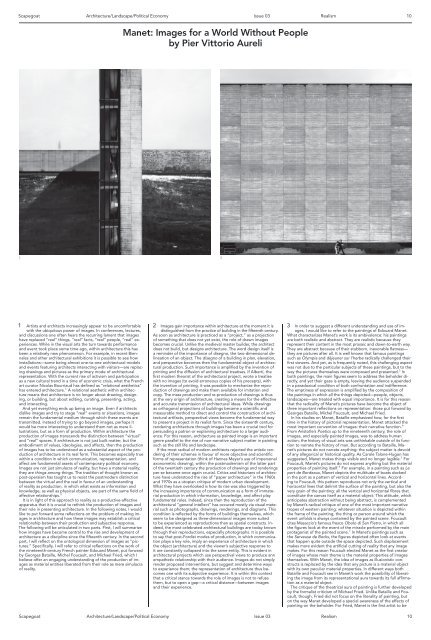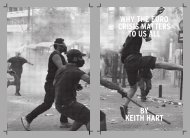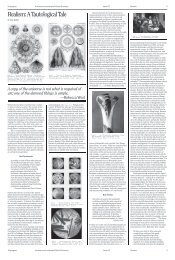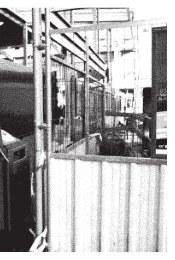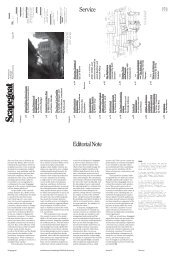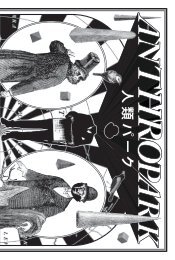Pier Vittorio AURELI, Manet - Scapegoat
Pier Vittorio AURELI, Manet - Scapegoat
Pier Vittorio AURELI, Manet - Scapegoat
You also want an ePaper? Increase the reach of your titles
YUMPU automatically turns print PDFs into web optimized ePapers that Google loves.
<strong>Scapegoat</strong> Architecture/Landscape/Political Economy<br />
Issue 03 Realism<br />
10<br />
<strong>Manet</strong>: Images for a World Without People<br />
by <strong>Pier</strong> <strong>Vittorio</strong> Aureli<br />
1 2<br />
1 Artists and architects increasingly appear to be uncomfortable<br />
with the ubiquitous power of images. In conferences, lectures,<br />
and discussions one often hears the recurring lament that images<br />
have replaced “real” things, “real” facts, “real” people, “real” experiences.<br />
While in the visual arts the turn towards performance<br />
and event took place some time ago, within architecture this has<br />
been a relatively new phenomenon. For example, in recent Biennales<br />
and other architectural exhibitions it is possible to see how<br />
installations—some being almost one-to-one architectural models<br />
and events featuring architects interacting with visitors—are replacing<br />
drawings and pictures as the primary mode of architectural<br />
representation. With the current rise of activism and participation<br />
as a new cultural trend in a time of economic crisis, what the French<br />
art curator Nicolas Bourriaud has defined as “relational aesthetics”<br />
has entered architecture. 1 A relational aesthetic within architecture<br />
means that architecture is no longer about drawing, designing,<br />
or building, but about editing, curating, presenting, acting,<br />
and interacting.<br />
And yet everything ends up being an image. Even if architects<br />
dislike images and try to stage “real” events or situations, images<br />
remain the fundamental medium through which these events are<br />
transmitted. Instead of trying to go beyond images, perhaps it<br />
would be more interesting to understand them not as mere illustrations,<br />
but as a form of production. Within architecture the<br />
production of images transcends the distinction between “virtual”<br />
and “real” spaces. If architecture is not just built matter, but the<br />
embodiment of values, ideologies, and affects, then the production<br />
of images has to be understood as a substantial aspect of the production<br />
of architecture in its real form. This becomes especially true<br />
within a condition in which communication, representation, and<br />
affect are fundamental assets of contemporary political economy.<br />
Images are not just simulacra of reality, but have a material reality;<br />
they are things among things. The tradition of thought known as<br />
post-operaism has taught us to resist the postmodern distinction<br />
between the virtual and the real in favour of an understanding<br />
of reality as production, in which what exists as information and<br />
knowledge, as well as physical objects, are part of the same field of<br />
affective relationships. 2<br />
It is in light of this approach to reality as a productive-affective<br />
apparatus that it is crucial to rethink the production of images and<br />
their role in presenting architecture. In the following notes, I would<br />
like to put forward some reflections on the problem of making images<br />
in architecture and how these images may establish a critical<br />
relationship between their production and subjective response.<br />
The following will be articulated in two parts. First, I will summarize<br />
how images have become central to the rise and development of<br />
architecture as a discipline since the fifteenth century. In the second<br />
part, I will reflect on the ontological dimension of images as “pictures.”<br />
Specifically, I will refer to critical reflections on the work of<br />
the nineteenth-century French painter Edouard <strong>Manet</strong>, put forward<br />
by Georges Bataille, Michel Foucault, and Michael Fried, which I<br />
believe offer an engaging understanding of the production of images<br />
as material entities liberated from their role as mere simulacra<br />
of reality.<br />
2 Images gain importance within architecture at the moment it is<br />
distinguished from the practice of building in the fifteenth century.<br />
As soon as architecture is practiced as a “project,” as a projection<br />
of something that does not yet exist, the role of drawn images<br />
becomes crucial. Unlike the medieval master builder, the architect<br />
does not build, but designs architecture. The word design itself is<br />
a reminder of the importance of disegno, the two-dimensional delineation<br />
of an object. The disegno of a building in plan, elevation,<br />
and perspective becomes then the fundamental object of architectural<br />
production. Such importance is amplified by the invention of<br />
printing and the diffusion of architectural treatises. If Alberti, the<br />
first modern theorist of the architectural project, wrote a treatise<br />
with no images (to avoid erroneous copies of his precepts), with<br />
the invention of printing, it was possible to mechanize the reproduction<br />
of drawings and make them available for imitation and<br />
copy. The mass production and re-production of drawings is thus<br />
at the very origin of architecture, creating a means for the effective<br />
and accurate transmission of architectural ideas. While drawings<br />
as orthogonal projections of buildings became a scientific and<br />
measurable method to direct and control the construction of architectural<br />
artifacts, perspectival views become the fundamental way<br />
to present a project in its realist form. Since the sixteenth century,<br />
rendering architecture through images has been a crucial tool for<br />
persuading a patron or explaining architecture to a larger audience.<br />
For this reason, architecture as painted image is an important<br />
genre parallel to the rise of non-narrative subject matter in painting<br />
such as the still life and landscape.<br />
If the most radical of modern architects rejected the artistic rendering<br />
of their schemes in favour of more objective and scientific<br />
forms of representation (think of Hannes Meyer’s use of impersonal<br />
axonometric drawing), within the postmodernism of the latter part<br />
of the twentieth century the production of drawings and renderings<br />
per se became once again crucial. Critics and historians of architecture<br />
have understood the rise of “paper architecture” in the 1960s<br />
and 1970s as a utopian critique of modern urban development.<br />
What they have overlooked is how its rise was also triggered by<br />
the increasing importance of communication as a form of immaterial<br />
production in which information, knowledge, and affect play<br />
fundamental roles. Indeed, since then the reproduction of the<br />
architectural “general intellect” has occured mostly via visual material<br />
such as photographs, drawings, renderings, and diagrams. This<br />
condition is reflected by the forms of buildings themselves, which<br />
seem to be designed as three-dimensional images more suited<br />
to be experienced as reproductions than as spatial constructs. Indeed,<br />
the most celebrated architectural buildings are today known<br />
through their reproductions, especially photographs. It is possible<br />
to say that post-Fordist modes of production, in which communication<br />
plays a key role, imply an experience of architecture in which<br />
the object (architecture) and the viewer’s subjective response to<br />
it are constantly collapsed into the same entity. This is evident in<br />
architectural projects which use perspectival views to produce ann<br />
empathetic relationship with their audience. Images do not simply<br />
render proposed interventions, but suggest and determine ways<br />
to experience them; the representation of architecture thus becomes<br />
one with its subjective experience. It is within this context<br />
that a critical stance towards the role of images is not to refuse<br />
them, but to open a gap—a critical distance—between images<br />
and their experience.<br />
3 In order to suggest a different understanding and use of images,<br />
I would like to refer to the paintings of Edouard <strong>Manet</strong>.<br />
What characterizes <strong>Manet</strong>’s work is its ambivalence: his paintings<br />
are both realistic and abstract. They are realistic because they<br />
represent their content in the most prosaic and down-to-earth way.<br />
They are abstract because of their stubborn, inexorable flatness—<br />
they are pictures after all. It is well known that famous paintings<br />
such as Olympia and déjeuner sur l’herbe radically challenged their<br />
first viewers. And yet, as is frequently noted, this challenging aspect<br />
was not due to the particular subjects of these paintings, but to the<br />
way the pictures themselves were composed and presented. 3 In<br />
both paintings, the main figures seem to address the beholder directly,<br />
and yet their gaze is empty, leaving the audience suspended<br />
in a paradoxical condition of both confrontation and indifference.<br />
The emptiness of expression is amplified by the composition of<br />
the paintings in which all the things depicted—people, objects,<br />
landscapes—are treated with equal importance. It is for this reason<br />
that the radicality of <strong>Manet</strong>’s pictures have become the object of<br />
three important reflections on representation: those put forward by<br />
Georges Bataille, Michel Foucault, and Michael Fried.<br />
In his studies on <strong>Manet</strong>, Bataille emphasized how, for the first<br />
time in the history of pictorial representation, <strong>Manet</strong> attacked the<br />
most important convention of images: their narrative function. 4<br />
From Aristotle’s Poetics up to the nineteenth century, the role of<br />
images, and especially painted images, was to address human<br />
action; the history of visual arts was unthinkable outside of its function<br />
to narrate the history of man. But according to Bataille, <strong>Manet</strong>’s<br />
pictures do not narrate anything: the subject matter is devoid<br />
of any allegorical or historical quality. As Carole Talone-Hugon has<br />
suggested, <strong>Manet</strong> makes things visible and no longer legible. 5 For<br />
Foucault, <strong>Manet</strong>’s pictures do not express anything but the material<br />
properties of painting itself. 6 For example, in a painting such as Le<br />
port de Bordeaux, <strong>Manet</strong> depicts the multitude of boats docked<br />
in the port as a pattern of vertical and horizontal lines. According<br />
to Foucault, this pattern reproduces not only the vertical and<br />
horizontal lines that delimit the surface of the painting, but also the<br />
very grain of the painting: all the vertical and horizontal fibres that<br />
constitute the canvas itself as a material object. This attitude, which<br />
anticipates abstraction without being abstract, is complemented<br />
by <strong>Manet</strong>’s radical critique of one of the most important narrative<br />
tropes of western painting: whatever situation is depicted within<br />
the frame of the painting, the thing or person around which the<br />
event unfolds is always contained by the painted scene. Foucault<br />
cites Masaccio’s famous fresco Obolo di San Pietro, in which all<br />
the figures look at the event of the miracle performed by the main<br />
protagonist of the painted scene. 7 In <strong>Manet</strong>’s paintings such as<br />
the Serveuse de Bocks, the figures depicted often look at events<br />
that happen quite outside the space depicted. Such displacement<br />
makes more evident the artificial cutting of reality that any image<br />
makes. For this reason Foucault elected <strong>Manet</strong> as the first creator<br />
of images whose main theme is the material properties of images<br />
themselves. With <strong>Manet</strong>, the idea of images as illusionistic constructs<br />
is replaced by the idea that any picture is a material object<br />
with its own peculiar material properties. In different ways both<br />
Bataille and Foucault see in <strong>Manet</strong>’s work the possibility of liberating<br />
the image from its representational aura towards its full affirmation<br />
as a material object.<br />
The critique of the theatrical aura of painting is further developed<br />
by the formalist criticism of Michael Fried. Unlike Bataille and Foucault,<br />
though, Fried did not focus on the literality of painting, but<br />
on the way <strong>Manet</strong> developed a special awareness of the effects of<br />
painting on the beholder. For Fried, <strong>Manet</strong> is the first artist to be<br />
<strong>Scapegoat</strong> Architecture/Landscape/Political Economy<br />
Issue 03 Realism<br />
10
<strong>Scapegoat</strong> Architecture/Landscape/Political Economy<br />
Issue 03 Realism<br />
11<br />
3 4<br />
fully aware of the problematics of looking at a picture. 8<br />
As is well known, the relationship between the artwork and its<br />
beholder has been the central focus of Fried’s criticism. For him,<br />
a work of art must be finite in itself and not dependant on the<br />
viewer’s subjective response. The moment art depends on subjective<br />
response it becomes “theatre,” loses its integrity, and interferes<br />
with the everyday experience of the beholder. As is also well<br />
known, Fried developed a critique of theatricality in his canonical<br />
essay “Art and Objecthood,” in which he attacked minimal art. 9 In<br />
this essay, he argued that the literalness of work by artists such as<br />
Donald Judd and Robert Morris implied that a work of art is always<br />
incomplete and requires the direct engagement of the viewer—and<br />
her capacity to move around the artwork—to be fully realized. In<br />
this way the boundary between art and what is not necessarily art<br />
is blurred in a situation that resembles our normal everyday condition.<br />
As Fried argues, “we are all literalists most of our lives.” 10 For<br />
this reason, Fried called for an art that was radically complete without<br />
the need to engage the active participation of the viewer. For<br />
Fried such art included, for example, the paintings by Morris Louis<br />
and Kenneth Noland, or the sculptures by Anthony Caro, in which<br />
what was expressed were the relationships within the work itself.<br />
For example, in paintings by Louis, the relationship between the<br />
rivulets or strips of colour and the rectangular blank canvas is so<br />
strong and complete that it presupposes an arrested, “transfixed”<br />
beholder in front of them. On the contrary, minimalist artworks<br />
are experienced through a situation of radical indeterminacy with<br />
respect to subjective response. This means that the intentions of<br />
the artists are no longer recognizable since they become confused<br />
with the subject’s experience of the artwork itself. It was within this<br />
preoccupation that Fried rediscovered Denis Diderot’s critique of<br />
theatricality in painting. 11 For Diderot, paintings were produced in<br />
order to be seen and this condition resulted in the excessive rhetorical<br />
play of the figures and scenes depicted. Diderot called for<br />
a painting style liberated from this primordial convention, as what<br />
was depicted would exist without a beholder in front of it. Fried<br />
recognized a Diderotian approach in the paintings of Chardin, such<br />
as Young Student Drawing, in which the French painter portrays<br />
a man seen from the back completely absorbed in the activity of<br />
drawing. Fried defined this condition of the subject as “absorption,”<br />
as opposed to the theatricality of more traditional painting in which<br />
everything is active in order to entertain the beholder. However,<br />
this interpretation of an anti-theatrical art came to a crisis when<br />
Fried was confronted with the work of <strong>Manet</strong>. Unlike the absorbed<br />
figures of Chardin’s pictures, in <strong>Manet</strong>’s paintings, the figures often<br />
address the beholder in an almost aggressive way. This is evident<br />
in famous pictures such as Le déjeuner sur l’herbe and Olympia.<br />
According to Fried, in these paintings the condition of beholding<br />
a picture is directly registered into the painting itself and thus<br />
the actual beholder is placed in an unprecedented position. Even<br />
though <strong>Manet</strong> is a theatrical painter in the Diderotian sense of the<br />
term, the radical frontal approach of his compositions—what Fried<br />
called the condition of “facingness”—makes evident the primordial<br />
convention that a picture must be beheld with a new force and<br />
explicitness. For Fried, such ostensible theatricality becomes a<br />
profound critique of theatricality, because by making it so explicitly<br />
evident, the painter reinforces the distance and thus the confrontation<br />
between the image and the beholder, who is then made aware<br />
of the constructedness of the picture itself.<br />
Recently, Fried has rediscovered such an approach in contemporary<br />
photography, especially the work of the photographers affiliated<br />
with the so-called Dusseldorf School, such as Andreas Gursky,<br />
Candida Höfer, and Thomas Struth. 12 In their work, the image is<br />
clearly constructed in order to be beheld. And yet it is precisely this<br />
factor that makes these photographs non-illusionistic depictions of<br />
reality. For example, as Fried has argued, Gursky’s images are spectacularly<br />
open to visual inspection because of their wealth of details,<br />
yet they rebut any possibility of representing a particular point<br />
of view that could be taken by someone in front of the photograph.<br />
For Fried, such a condition of radical facingness produces a “severing”<br />
effect between the photograph and the viewer. By reading<br />
the paintings of <strong>Manet</strong> and the work of these contemporary photographers,<br />
Fried seems to suggest the possibility that images can<br />
be radically themselves by emphazising their condition of being<br />
beheld. By making clear that the image is made in order to be seen,<br />
the producer of the image destroys the aura of the picture, which is<br />
its illusionistic status, its claim to offer a privileged “view” on reality.<br />
Above all, the severing of images from the viewer attacks one<br />
of the most crucial powers of images: inviting the viewer to interact<br />
with them by identifying her real experience of space with what is<br />
depicted in the image. Such interaction and identification between<br />
picture and viewer, subject, and object, is today a fundamental<br />
characteristic of the productive and re-productive apparatuses of<br />
the post-Fordist economy in which subjects are governed by making<br />
them active participants in the spectacular production of their<br />
own experience. The work of <strong>Manet</strong>, and the critical discourse that<br />
it originated, suggests a radical alternative to the contemporary<br />
regime of image production, as well as the production of architecture.<br />
This radical alternative consists in assuming that images are<br />
finite constructs, material objects with their own material properties.<br />
The radical lesson of <strong>Manet</strong>’s images is that they are not mere fragments<br />
of the world; rather, they are objects in themselves that not<br />
despite, but because they accept and even exalt their condition of<br />
being beheld, confront beholders as something separated, severed<br />
from them. ×<br />
Images Captions<br />
Diploma Projects,<br />
Architectural Association, London.<br />
Tutors: <strong>Pier</strong> <strong>Vittorio</strong> Aureli,<br />
Barbara Campbell -Lange, Fenella Collingridge.<br />
left to right:<br />
1. Jorgen Tandberg, Immeuble Cité in Antwerpen:<br />
A house for 1600 inhabitants, perspective,<br />
2010.<br />
2. Jorgen Tandberg, Immeuble Cité in Antwerpen:<br />
A house for 1600 inhabitants, perspective,<br />
2010.<br />
3. Tijn van de Wijdeven, We Need Stuff:<br />
Emptiness as a strategy, interior, 2011.<br />
4. Tijn van de Wijdeven, We Need Stuff:<br />
Emptiness as a strategy, promenade, 2011.<br />
Notes<br />
1. Nicholas Bourriaud, Relational Aesthetics<br />
(Paris: Le Press du Réel, 1998).<br />
2. See especially Christian Marazzi, Capital<br />
and Affects (Los Angeles: Semiotext(e),<br />
2010).<br />
3. Michael Fried, <strong>Manet</strong>’s Modernism, or, The<br />
Face of Painting in the 1860s (Chicago:<br />
University of Chicago Press, 1998), 25.<br />
4. Georges Bataille, <strong>Manet</strong> (Geneva: Skira,<br />
1955).<br />
5. Carole Talon-Hugon, “<strong>Manet</strong> o lo smarrimento<br />
dello spettatore”, in Michel Foucault, La<br />
pittura di <strong>Manet</strong>, ed. Maryvonne Saison,<br />
trans. Simona Paolini (Milan: Abscondita,<br />
2005), 75.<br />
6. Michel Foucault, <strong>Manet</strong> and the Object of<br />
Painting (London: Tate, 2011), 15.<br />
7. Ibid., 50.<br />
8. Fried, <strong>Manet</strong>’s Modernism, 18.<br />
9. Michael Fried, “Art and Objecthood,” in<br />
Artforum 5 (April 1967): 12-23. Reprinted in<br />
Michael Fried, Art and Objecthood (Chicago:<br />
The University of Chicago Press, 1998),<br />
148-172.<br />
10. Ibid., 168.<br />
11. Michael Fried, Absorption and Theatricality:<br />
Painting and Beholder in the Age of Diderot<br />
(Chicago: University of Chicago Press,<br />
1998).<br />
12. Michael Fried, Why Photography Matters As<br />
Art As Never Before (New Haven, London:<br />
Yale University Press, 2008).<br />
<strong>Pier</strong> <strong>Vittorio</strong> Aureli is an architect and<br />
educator. He is the co-founder of Dogma, and<br />
teaches at the Architectural Association in<br />
London. Aureli is the author of several books,<br />
including The Project of Autonomy: Politics<br />
and Architecture Within and Against Capitalism<br />
(2008), and The Possibility of an Absolute<br />
Architecture (2011).<br />
<strong>Scapegoat</strong> Architecture/Landscape/Political Economy<br />
Issue 03 Realism<br />
11


